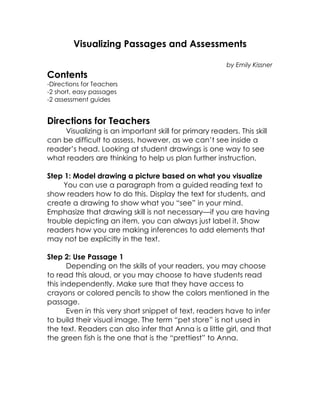
Visualizing Passages and Assessments
- 1. Visualizing Passages and Assessments by Emily Kissner Contents -Directions for Teachers -2 short, easy passages -2 assessment guides Directions for Teachers Visualizing is an important skill for primary readers. This skill can be difficult to assess, however, as we can’t see inside a reader’s head. Looking at student drawings is one way to see what readers are thinking to help us plan further instruction. Step 1: Model drawing a picture based on what you visualize You can use a paragraph from a guided reading text to show readers how to do this. Display the text for students, and create a drawing to show what you “see” in your mind. Emphasize that drawing skill is not necessary—if you are having trouble depicting an item, you can always just label it. Show readers how you are making inferences to add elements that may not be explicitly in the text. Step 2: Use Passage 1 Depending on the skills of your readers, you may choose to read this aloud, or you may choose to have students read this independently. Make sure that they have access to crayons or colored pencils to show the colors mentioned in the passage. Even in this very short snippet of text, readers have to infer to build their visual image. The term “pet store” is not used in the text. Readers can also infer that Anna is a little girl, and that the green fish is the one that is the “prettiest” to Anna.
- 2. Step 3: Use the assessment sheet to focus on what children represent in their drawings and plan further instruction. Few elements represented in drawing: If the child does not represent many ideas from the text, try reading aloud the passage to see if visualizing improves. If not, work on reading with retelling figures to help the reader match words from the text with images. (See the work of Dr. Arthur Glenberg for more research on this.) Drawing contains literal components only: This child is having trouble with making inferences to build a mental model. Try working with mystery passages, in which the reader has to infer what the item or setting is from some clues. Work with the reader to think about what is in the text, and what he or she can imagine by combining text clues and background knowledge. Drawing contains misinterpretations: These readers are tricky to deal with. In some cases, it’s worth a conversation with students to figure out where the misinterpretations came from. Often, a misinterpretation might arise from a reading miscue or a misunderstanding of a multiple meaning word. Step 4: Use Passage 2 to check for progress How are students progressing? Use the second passage to see how students are doing.
- 3. Visualizing 1 Directions: Read the passage. In the box, draw a picture to show what you visualize. Anna looked at the tanks of fish. She saw a green fish, a yellow fish, and a red fish. In the corner, a crab was hiding behind a rock. “What do you think, Anna?” Mom asked. “Would you like to buy one?” Anna grinned. “I want the green one!” she said. “It’s the prettiest.”
- 4. Visualizing 2 Directions: Read the passage. In the box, draw a picture to show what you visualize. “I want it!” TJ whined. He squirmed in his seat in the shopping cart. “I want the Lego toy!” “Mom said we aren’t buying any toys today,” Lexie told him. She pushed him down the long row of toys. “You’ll have to wait until your birthday.”
- 5. Assessment Sheet: Passage 1 Student name Date Passage 1: This passage describes a girl at a pet store with her mother. She is looking at the tanks of fish.
- 6. Assessment Sheet: Passage 2 Student name Date Passage 2: This passage describes a boy and a girl in the toy department of a store. The boy, TJ, is in a shopping cart. He wants a toy. Lexie is pushing the shopping cart. Literal Components: These Inferential Components: These elements are explicitly stated elements are implied in the in the text. text. Does the drawing somehow _____TJ represent these ideas? _____TJ sitting in the cart _____Lego toy _____ Lexie is older than TJ _____Lexie _____ TJ is unhappy _____ row of toys _____ They are in a store _____TJ does not have the toy ______TJ is a baby/toddler Misinterpretations: Make a note of elements in the drawing that show a misinterpretation of the text. Exceeds Meets Working toward Does not meet expectations: expectations: expectations: expectations: The drawing The drawing The drawing The drawing shows a clear shows an shows a basic does not show understanding of understanding of understanding of an the passage by the passage by the passage by understanding of including both including most including literal the text. literal and literal and some components. inferential inferential components. components.
- 7. More on visualizing The Forest and the Trees by Emily Kissner A chapter on visualizing discusses how readers use details to build visual images. Visualizing Powerpoint and activities This folder includes a Powerpoint to introduce visualizing and several stories that you can use with readers in grades 2-5. ($3.00 from TeachersPayTeachers) Visualizing Lesson: Story and ActivitiesThis lesson includes retelling figures to help students connect text with images. ($2.00 from TeachersPayTeachers) Chronological Order Texts for Teaching Text Structure See the text “Making Apple Butter” for a visualizing activity to help older students visualize complex text. Seven other texts with text- dependent questions included ($3.00 from TeachersPayTeachers) Retelling Nonfiction This text includes retelling figures to help students retell and visualize nonfiction text (free from TeachersPayTeachers)
